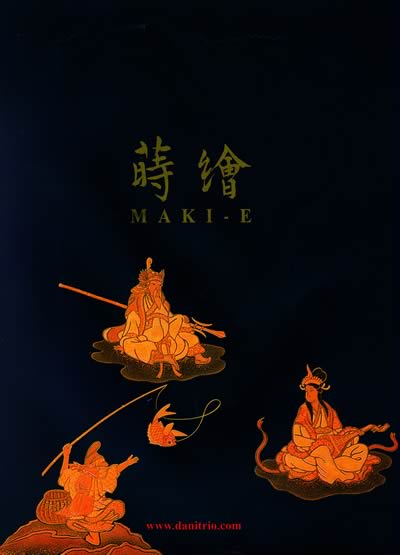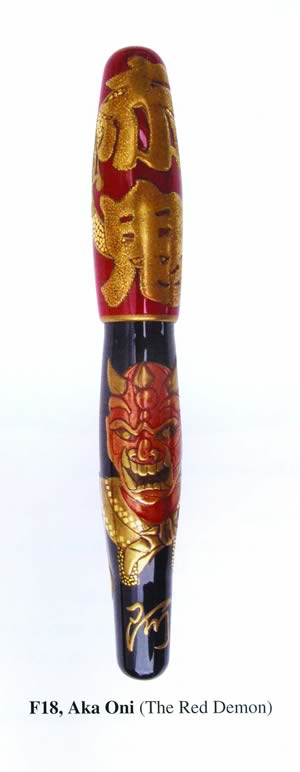|

An extraordinary book. Author Bernard Lyn assembles for the first time definitive
examples and explanations of this ancient art form with over 100 lavish illustrations
of skilled artisans and their creations in life-size and over-size graphics. This
book is not meant to sit on a coffee table. To any avid pen collector it would
serve as a valid and qualified source of information relative to Maki-e arts and
the Japanese history of pen making.
Whether you are new to Maki-e arts or not, this book will serve as an excellent
education covering not only the history of this ancient art form and also detailed
examples of how Maki-e designs are created on fountain pens. This book is a journey
from the very start of the Urushi sap collection process, the skilled artists,
the various Maki-e decoration styles and to the final creation of a beautiful
Maki-e writing instrument.

Materials for Maki-e
Maki-e (pronounced “Ma” as in “mat”, “Ki”
as in “kit” and “e” as in “Edward” was created
by Japanese in the 8th Century, and even today Maki-e can only be found in Japan
due to its complicated techniques of painting which require both exceptional talent
and incredible endurance. “Maki” of Maki-e means “sprinkling”
or “sowing”, and “e” means “paintings”. Sprinkling
gold or silver powders is one of the special characteristics of Maki-e. A good
Maki-e artist needs not only natural talent, but has also usually begun training
in the art form from a very early age. Many years of apprenticeship to his master
are required before he is able to begin creating his own Maki-e. Just as an athlete
needs a healthy mind and body, it is widely believed that Maki-e artists need
strong cultural backgrounds in order to produce good Maki-e work.

The author takes the reader on a grand tour of over thirty major Urushi/Maki-e
centers throughout Japan, and they all boast their special techniques and their
hundreds of years of decorating history. One who is greatly familiar with Maki-e
can tell from the finished art the source of this product by the design, patterns
or Urushi painting. For example, Hiraizumi in Iwate Prefecture is well known for
their Hidehira-nuri designing with gold leaves. Johoji in Iwate Prefecture is
famous for their Tame-nuri. Certain patterns, textures and designs can be identified
to particular artists who will specialize with the use of certain materials. The
themes of Maki-e decoration are usually drawn from nature, illustrating birds,
fish, Dieties, Demons and Gods, landscapes or simply dazzling effects of gold
or silver dust. The pens themselves are usually formed from ebonite but animal
horn is also used.

The various sources and natural ingredient qualities of Urushi are explained,
describing the differences of Urushi sap from various Asian countries. Weather,
wind, moisture and soil are the inherent ingredients as there are over 600 species
of Urushi trees. The collecting, harvesting methods and processing of Urushi will
vary greatly by region, the time of year it is harvested from June to September
and the care of this process determines the final quality.

Other Major Techniques
Bernard Lyn explains that Maki-e was created in Japan 1,400 years ago. Togidashi-Maki-e
was created in the Nara Period (646-794) and Urushi knowledge came from China
during the Tang Dynasty (618-907) showing artisans how to add colors and gold
materials to make objects more beautiful. Essentially Maki-e is a unique art form
sowing gold, silver or platinum powders onto wet Urushi. Other precious materials
such as abalone, corals, pearl, tortoise shells and ivory in fine thin layers
(called Raden) are applied to contour lines drawn upon sticky Urushi to form elaborate
designs. There are countless combinations of techniques to achieve a certain balance,
beauty or transparency to the finished Maki-e design. Many of these techniques
are explained in detail showing every step of creation and also a profile or biography
of the artist.

Tools for Maki-e
Th author explains to us that among the most important tools used to create
Maki-e are Fude (brushes) and other brushes. Some are made from only certain animal
hairs based on their own characteristics. The brushes are made with the hair of
mice, but only the hairs that grow on the back of mice can be used. Other sources
for such extremely fine brushes are cat, fox, horse, squirrel hairs and from other
species, with some of these brushes costing at least $500.
Without question the most valuable ingredient to produce Maki-e pens is the
talent of the artists. In the early 1900’s there were around 500 fountain
pen related firms in Tokyo alone. In addition to Pilot, Sailor and Platinum there
were about 100 turneries producing pens and 60 each of gold nib makers and lacquer
artists. Today all of these are gone, there are so few artisans left that are
still working on genuine ebonite eye dropper fountain pens by hand.
The fountain pen community is grateful to Bernard Lyn for this monumental
work bringing this age old art form to the attention of not only pen collectors
world wide but all those who appreciate the art of Maki-e.
ISBN 957-9403-07-4 Publisher: Dani International Corp Publishing
Year: 2003
1St Edition 1St Print Language: English Book Format: Hard Cover
Book Dimensions: 19x26.5 cm 255 Pages
Suggested retail price : $89.
Bernard Lyn –
Danitrio International Corp is the manufacturer of Danitrio fountain pens
http://www.danitrio.com
Only 1500 copies of this book have been printed
They are available from Ray Adams at Wood ‘N Dreams

|